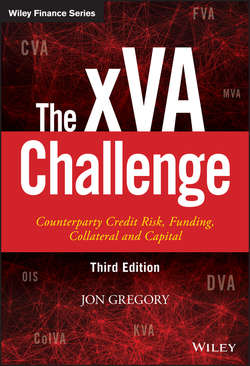Читать книгу The xVA Challenge - Gregory Jon - Страница 8
На сайте Литреса книга снята с продажи.
1
Introduction
ОглавлениеGet your facts first, then you can distort them as you please.
Mark Twain (1835–1910)
In 2007, a so-called credit crisis began. This crisis eventually became more severe and long-lasting than could have ever been anticipated. Along the way, there were major casualties such as the bankruptcy of the investment bank Lehman Brothers. Many banks were seen as being extremely reckless in the run-up to the crisis by taking excessive risks to provide gains for their employees and shareholders, and yet were inadequately capitalised for these risks. Governments around the world had to bail out other financial institutions such as American International Group (AIG) in the US and the Royal Bank of Scotland in the UK, and it became clear that it was essentially the taxpayer that was implicitly providing the capital against the risks being taken. AIG required more than $100 billion of taxpayers’ money to cover losses due to the excessive risk-taking. Many taxpayers have since faced poor economic conditions and have experienced the cost of these bailouts via higher taxes and reduced government spending.
One result of the “global financial crisis” (as the events from 2007 onwards shall generally be referred to in this book) was a clear realisation that banks needed to be subject to much stricter regulation and conservative requirements over aspects such as capital. It has become all too clear that there has been a significant “too big to fail” problem in that the biggest banks and financial firms could not be allowed to fail and therefore should be subject to even tighter risk controls and oversight. It was therefore obvious that there would need to be a massive shift in the regulatory oversight of banks and large financial firms. Rules clearly needed to be improved, and new ones introduced, to prevent a repeat of the global financial crisis.
It is not, therefore, surprising that new regulation started to emerge very quickly with the Dodd–Frank Act, for example, being signed into law in July 2010, and totalling almost one thousand pages of rules governing financial institutions. In addition, Basel III guidelines for regulatory capital have been developed and implemented relatively rapidly (compared with, for example, the previous Basel II framework). Much of the regulation is aimed squarely at the over-the-counter (OTC) derivatives market where aspects such as counterparty risk and liquidity risk were shown to be so significant in the global financial crisis.
This pace and range of new regulation has been quite dramatic. Additional capital charges, a central clearing mandate and bilateral rules for posting of collateral have all been aimed at counterparty risk reduction and control. The liquidity coverage ratio and net stable funding ratio have taken aim more at liquidity risks. A leverage ratio has been introduced to restrict a bank’s overall leverage. An idea of the proliferation of new regulation in OTC derivatives can be seen by the fact that the central clearing mandate led to new capital requirements for exposure to central counterparties which in turn (partially) required a new bilateral capital methodology (the so-called SA-CCR discussed in Chapter 8) to be developed. Not surprisingly, there are also initiatives aimed at rationalising the complex regulatory landscape such as the fundamental review of the trading book. For a typical bank, even keeping up with regulatory change and the underlying requirements is challenging, let alone actually trying to adapt their business model to continue to be viable under such a new regulatory regime.
At the same time as the regulatory change, banks have undertaken a dramatic reappraisal of the assumptions they make when pricing, valuing and managing OTC derivatives. Whilst counterparty risk has always been a consideration, its importance has grown, which is seen via significant credit value adjustment (CVA) values reported in bank’s financial statements. Banks have also realised the significant impact that funding costs, collateral effects and capital charges have on valuation. Under accounting rules, CVA was subject to a very strange marriage to DVA (debt value adjustment). Nonetheless, this marriage has produced many offspring such as FVA (funding value adjustment), ColVA (collateral value adjustment), KVA (capital value adjustment) and MVA (margin value adjustment). OTC derivatives valuation is now critically dependent on those terms, now generally referred to as xVA.
It is important not to focus only on the activities of banks but also to consider the end-users who use OTC derivatives for hedging the economic risks that they face. Whilst such entities did not cause or catalyse the global financial crisis, they have been on the wrong end of increasing charges via xVA, partially driven by the regulation aimed at the banks they transact with. The activities of these entities has also changed as they have aimed to understand and optimise the hedging costs they face.
Hence, there is a need to fully define and discuss the world of xVA, taking into account the nature of the underlying market dynamics and new regulatory environment. This is the aim of this book. In Chapters 2–4 we will discuss the global financial crisis, OTC derivatives market and birth of xVA in more detail. Chapters 5–9 will cover methods for mitigating counterparty risk and underlying regulatory requirements. Chapters 10–12 will discuss the quantification of key components such as exposure, default probability and funding costs. Chapters 13–16 will discuss the different xVA terms and give examples of their impact. Finally, in Chapters 17–20 we will discuss the management of xVA at a holistic level and look at possible future trends.
